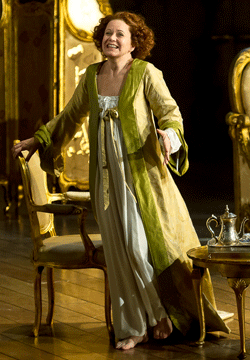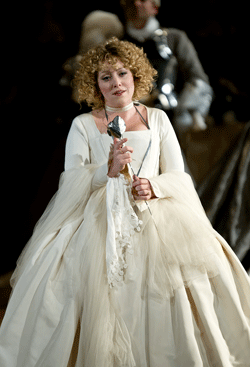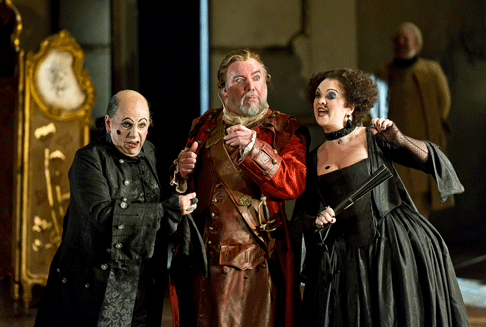08 Feb 2012
Der Rosenkavalier, ENO
English National Opera’s revival of Richard Strauss’s fin de siècle Figaro is a heart-warming treat for a cold winter’s night.

English National Opera’s revival of Richard Strauss’s fin de siècle Figaro is a heart-warming treat for a cold winter’s night.
Director David McVicar’s self-designed staging perfectly balances detail and spaciousness — an accomplished feat and a productive one; although the score is complex and infinitely nuanced, McVicar has been able to identify which details to foreground visually and which to allow to reside in the musical foundations. So, there is finely judged attention to detail but the resulting drama is not fussy or cluttered.
 Amanda Roocroft as The Feldmarschallin
Amanda Roocroft as The Feldmarschallin
A single backdrop suffices: a curving Regency interior, slightly past its prime but still offering elegant evidence of the stylish sophistications of yesteryear — much like the Marschallin herself. Gilt and bronze drapes, curling creepers and cobwebbed chandeliers create a fairy-tale otherworldliness, and this is enhanced by Paule Constable’s clever lighting which, evoking subdued candlelight — the front of stage decked with row of crumbling candles (which Valzacchi snappily switches on at the start of the Mariendal scene) — establishes an ethereal distance. And, in the fading light of Act 1, a deepening, looming shadow of the Marschallin provides a visual echo of the ‘former’ self whose passing she laments.
McVicar’s direction judiciously mixes dense and intricate movements — as during the spooking of Ochs in the inn scene, when tumblers and goblins cavort and cartwheel wildly across the stage — with gentler gestures which flow as organically as Strauss’s score, particularly in the closing moments. The extremes of the wide stage are deployed to depict the emotional distance between characters; and at the close to emphasise the Marschallin’s isolation from the young lovers.
 Sophie Bevan as Sophie
Sophie Bevan as Sophie
John Tomlinson’s Baron Ochs of Lerchenau is a Falstaffian scally-wag, with all the bluff, swagger and ultimately forgivable self-interest of his Shakespearean predecessor. We may cringe at his hapless fumbling after any helpless female within arm’s reach; find his empty boasts and groundless vanity infuriating and his class-obsessed condescension distasteful. But, his candid self-knowledge and readiness to greet defeat with big-hearted generosity win our tolerance, tenderness and even, in the end, our pity. This is a comic turn par excellence, one which fortunately does not lapse into caricature; and, the humour is never achieved at the expense of musical control or accuracy. A master of crisp diction, Tomlinson’s every syllable is crystal clear. Weighty but flexible, his bright, gleaming tone is a joy, and it loses none of its gloss as he descends to the depths of his register. It may be a little over-strained at the top, but who cares? This Ochs relishes the amorous games even if they end in a rout; and Tomlinson’s complete delight in the theatrical and musical world which encompasses him is equally apparent.
As the elegant Marschallin, Amanda Roocroft is regal of bearing and radiant of voice; if she doesn’t quite have the velvety roundness of the ideal Straussian heroine, she uses light and shade to movingly reveal the Marschallin’s insecurities, the piano reflections of her Act 1 monologue wistfully conveying muted resignation.
The lustrous spin of Sophie Bevan’s response to the bestowal of the silver rose would melt the shining breastplate of even the most cold-blooded Rosenkavalier. Bevan captures both the tempestuousness of the feisty adolescent and the nascent serenity of the mature woman within. This Sophie is no slight soubrette; and in the Act 3 trio the Marschallin clearly recognises her rival’s powerful charm and determined will.
Sarah Connolly inhabits the eponymous envoy’s breeches with total authority, utterly convincing as the excitable young romancer who learns that the path of true love never quite runs smooth. By turns ebullient and grave, bullish and wistful, Connolly has unostentatiously mastered every nuance of character, even adopting a convincing rural brogue for the Act 3 deception of Ochs. Particularly resounding in her upper register, Connolly’s doubtful hesitation when forced to choose between past and future loves is painfully touching.
 Adrian Thompson as Valzacchi, Sir John Tomlinson as Baron Ochs and Madeleine Shaw as Annina
Adrian Thompson as Valzacchi, Sir John Tomlinson as Baron Ochs and Madeleine Shaw as Annina
A master of comic timing, Andrew Shore is typically impressive as the exasperated Herr von Faninal; Shore alone matched Tomlinson in his use of the text, though as his partner-in crime, Annina, Madeleine Shaw is confident and vocally arresting. And, there are many fine performances from those taking the smaller character roles, including Jennifer Rhys-Davis as Sophie’s chaperone — her urgent proddings with her fan keep her young charge firmly in line during her conversation with the rose bearer — and Gwyn Hughes Jones who produces a stunning Italianate glean as he entertains the Marschallin in Act 1 (and whose petulant flounce and pout indicates his irritation when his star turn is prematurely halted!). Ericson Mitchell is rather older than the prepubescent boys who are usually cast to play Mohammed, the Marschallin’s page, and I’m not sure his crafty retrieval of Sophie’s handkerchief and bold final bow to the audience really captures the cheeky breeziness of the closing bars of the score; but his presence does add an edgy touch of adolescent knowingness to the goings-on in the Marschallin’s boudoir.
Edward Gardner's reading of Strauss’s wonderfully evocative score is expansive and luscious. He creates an opulent but airy bed of sound through which a multitude of minutiae effortlessly reveal themselves: sinuous, seductive clarinet coils; impassioned horn commentaries; rising celli climaxes. Tempi are at times quite idiosyncratic — the final trio is slow, and Och’s waltzes wistfully elongated — but this complements, rather than negates, the dramatic flow. This is superb orchestral playing with scarcely a note out-of-place or ill-judged; the precision of chamber music within a vast orchestral canvas.
Claire Seymour